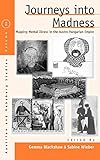Journeys Into Madness : Mapping Mental Illness in the Austro-Hungarian Empire / ed. by Sabine Wieber, Gemma Blackshaw.
Material type: TextSeries: Austrian and Habsburg Studies ; 14Publisher: New York ; Oxford : Berghahn Books, [2012]Copyright date: ©2012Description: 1 online resource (222 p.)Content type:
TextSeries: Austrian and Habsburg Studies ; 14Publisher: New York ; Oxford : Berghahn Books, [2012]Copyright date: ©2012Description: 1 online resource (222 p.)Content type: - 9780857454584
- 9780857454591
- 362.196/89009436 23
- RC450.A9 J68 2012
- online - DeGruyter
| Item type | Current library | Call number | URL | Status | Notes | Barcode | |
|---|---|---|---|---|---|---|---|
 eBook
eBook
|
Biblioteca "Angelicum" Pont. Univ. S.Tommaso d'Aquino Nuvola online | online - DeGruyter (Browse shelf(Opens below)) | Online access | Not for loan (Accesso limitato) | Accesso per gli utenti autorizzati / Access for authorized users | (dgr)9780857454591 |
Browsing Biblioteca "Angelicum" Pont. Univ. S.Tommaso d'Aquino shelves, Shelving location: Nuvola online Close shelf browser (Hides shelf browser)

|

|

|

|

|

|

|
||
| online - DeGruyter Centering the Margin : Agency and Narrative in Southeast Asian Borderlands / | online - DeGruyter Peter Lorre: Face Maker : Constructing Stardom and Performance in Hollywood and Europe / | online - DeGruyter Lost Objects Of Desire : The Performances of Jeremy Irons / | online - DeGruyter Journeys Into Madness : Mapping Mental Illness in the Austro-Hungarian Empire / | online - DeGruyter The Politics of Education Reform in the Middle East : Self and Other in Textbooks and Curricula / | online - DeGruyter Hitler's Plans for Global Domination : Nazi Architecture and Ultimate War Aims / | online - DeGruyter Cultures of Colour : Visual, Material, Textual / |
Frontmatter -- CONTENTS -- List of Figures -- Introduction -- 1. The Mad Objects of Fin-de-Siècle Vienna: Journeys, Contexts and Dislocations in the Exhibition ‘Madness and Modernity’ -- 2. Solving Riddles: Freud, Vienna and the Historiography of Madness -- 3. Symphonies and Psychosis in Mahler’s Vienna -- 4. Creating an Appropriate Social Milieu: Journeys to Health at a Sanatorium for Nervous Disorders -- 5. Travel to the Spas: The Growth of Health Tourism in Central Europe, 1850–1914 -- 6. Vienna’s Most Fashionable Neurasthenic: Empress Sisi and the Cult of Size Zero -- 7. Peter Altenberg: Authoring Madness in Vienna circa 1900 -- 8. ‘Hell Is Not Interesting, It Is Terrifying’: A Reading of the Madhouse Chapter in Robert Musil’s The Man without Qualities -- 9. Reason Dazzled: Klimt, Krakauer and the Eyes of the Medusa -- 10. Mapping the Sanatorium: Heinrich Obersteiner and the Art of Psychiatric Patients in Oberdöbling around 1900 -- 11. The Württemberg Asylum of Schussenried: A Psychiatric Space and Its Encounter with Literature and Culture from the ‘Outside’ -- Select Bibliography -- Notes on Contributors -- INDEX
restricted access online access with authorization star
http://purl.org/coar/access_right/c_16ec
At the turn of the century, Sigmund Freud’s investigation of the mind represented a particular journey into mental illness, but it was not the only exploration of this ‘territory’ in the Austro-Hungarian Empire. Sanatoriums were the new tourism destinations, psychiatrists were collecting art works produced by patients and writers were developing innovative literary techniques to convey a character’s interior life. This collection of essays uses the framework of journeys in order to highlight the diverse artistic, cultural and medical responses to a peculiarly Viennese anxiety about the madness of modern times. The travellers of these journeys vary from patients to doctors, artists to writers, architects to composers and royalty to tourists; in engaging with their histories, the contributors reveal the different ways in which madness was experienced and represented in ‘Vienna 1900’.
Mode of access: Internet via World Wide Web.
In English.
Description based on online resource; title from PDF title page (publisher's Web site, viewed 25. Jun 2024)


